Categories of automatic switches. Marking of automatic switches. Types, characteristics and purpose of circuit breakers. Short circuit currents
Everyone knows that circuit breakers are nothing more than a mechanical switching device designed for:
- switching on, conducting and switching off currents under conditions normal state chains,
- as well as for switching on, holding for a certain period of time and automatic shutdown currents in conditions of an abnormal state of the circuit - the so-called currents short circuit and high currents caused by network overload.
Short-circuit currents are worked out by circuit breakers with a bang, since modern releases manage to absolutely accurately detect a short circuit and turn off the load within fractions of a second, without even a hint of damage to equipment and conductors.
Characteristic type "A"
At low voltage, two types of selectivity are mainly used: amperometric selectivity and chronometric selectivity. It consists of a maximum current to give different timings for the protections staggered along the network. At the beginning of each section, ammeter protection is provided: its threshold is set to a value below the minimum short circuit value caused by a fault in the supervised section and greater than the maximum current value caused by a fault located in the downstream; Logic selectivity. This system is designed to overcome the disadvantages of chronometric selectivity. It is used when a short time to fix a defect is required. The exchange of logical information between successive protections makes it possible to eliminate selectivity intervals and, therefore, significantly reduce the delay in the operation of switches located closest to the source; Selectivity through directional protection. In a closed network where there is a fault at both ends, it is necessary to use protection that is sensitive to the direction of fault current flow in order to be able to selectively find and eliminate it. the role of directional maximum current protection. Protection actions will differ depending on the direction of the current. Therefore, the relay must have both current and voltage information; Differential selectivity - these protections compare the currents at both ends of the controlled section of the network. Any difference in amplitude and phase between these currents indicates the presence of a fault: the protection only responds to faults within the closed area and is insensitive to any external fault; Combined selectivity. Mixed selectivity is a combination of elementary selectivity functions that provide benefits in addition to simple selectivities.
- Chronometric selectivity.
- These delays are longer because the relay is closer to the source.
- The indicated fault is considered by all protections.
But with overload currents, the situation is more complicated. Such currents do not differ much from the rated ones, and even for a certain period of time they can flow through electrical circuit absolutely no consequences. That is why there is no need to instantly turn off such a current, because the overload current may be short-term. The main problem is that each network has its own overload limit and not even one.
Important data for circuit breakers
The second part is dedicated to circuit breakers with the following areas. The principle of the circuit breaker, the design of the circuit breaker, the breakdown of the circuit breaker, the characteristics of the circuit breaker, fuse selectivity. Normal breaking current, the current at which the circuit breaker is set.
1.13 times B - the circuit breaker will be installed in more than an hour 1.45 times B - the circuit breaker will be installed in less than an hour. The short circuit breaking capacity is the amount of short circuit current that the circuit breaker can still break.
For some types of currents, it is possible to allocate the maximum value of the time until the circuit is turned off. It can range from a few seconds to several tens of minutes, but the possibility should be excluded. false positive. If the current does not pose any danger to the network, then the shutdown should not occur either in a second or in a day.
Unlike a fuse, it is non-destructive protective device and can be reused after shutdown. The correct function of the circuit breaker is provided by two loudspeakers - thermal and electromagnetic short-circuited contacts.
The circuit breaker principle is further explained with the help of an illustration. If a short circuit occurs while a device is connected, the short circuit current reacts immediately to an electromagnetic short circuit. Trigger mechanism short circuit short circuit is almost instantaneous, its response is on the order of tens of milliseconds. If the device is unacceptably overloaded for a long period of time, an electromagnetic short circuit, but the thermostat does not respond to the current overload.
Modern circuit breakers have three types of releases:
- Mechanical - manual on and off,
- Electromagnetic - shutdown in case of short circuit,
- Thermal - overload protection.
This feature means:
With the passage of a bimetallic flow, this strip heats up and, due to different thermal expansion, deformation occurs, the tape bends, the anchor is suppressed and, therefore, the lock is released, the freewheel, so that the overloaded device automatically turns off.
The speed of the thermal release reaction depends on the magnitude of the current overload and is on the order of several tens of seconds, up to several tens of minutes in currents with a lower rated current. For circuit breakers more than 100 A, an electrodynamic short-circuit release is used. Fixed and moving contacts are arranged in parallel. The short-circuit current flows through the contacts in the opposite direction, and the moving contact is switched off by the force that causes the short-circuit current.
- The range at which the overload protection operates. It is determined by the parameters of the bimetallic plate built into the apparatus, such a plate is capable of bending and breaking the circuit during a large flow through it. electric current. For fine tuning, it is enough to tighten this very plate with an adjusting screw.
- The range at which the overcurrent protection operates, due to the parameters of the solenoid built into the switch.
Characteristics of circuit breakers:
Tripping characteristic of the circuit breaker
Difference between electromagnetic and electrodynamic triggers. The circuit breaker can be switched on again by pressing the button, and only if the error causing the unacceptably high current has been eliminated. Depending on the switching characteristics.
- overhead line with blowout.
- Spring-loaded electromagnetic pressure motor.
MA characteristic: absence thermal release because it is not always required. For example, protection of electric motors is often carried out using overcurrent relays. In this case, the machine is needed only as a means of protection against short circuits.
Feature A: the thermal release trips at currents that exceed the rated value by 30%. It will take about an hour to turn off. If the current exceeds the nominal value twice, then the electromagnetic release will come into play, the response time of which is 0.05 seconds. If, for some reason, the solenoid does not work when the rated current is doubled, the thermal release will take about 20-30 seconds to disconnect the load. When the nominal value is exceeded by three times, the electromagnetic release will operate without any delay, and will disconnect the load in hundredths of a second. Such circuit breakers are used in circuits where transient overloads are not expected to occur during normal operating conditions. An example is a circuit in which devices are connected that contain semiconductor elements that fail even with a slight excess of current.
These characteristics represent the behavior of the safety element depending on the magnitude of overvoltages. In particular, they indicate how long the security element is disabled if a certain amount of direct current. They are presented in tabular form or, for greater clarity and readability, they are expressed graphically in rectangular coordinates. The axes have logarithmic scales.
The current is expressed as a multiple of the rated current of the fastener or directly in amperes. In some cases, for certain purposes, it is recommended to express the tripping characteristic not as a band, but with one line. In this case, the "one axis" characteristic passes through 75% of the current band.
Feature B: her distinguishing feature in that the electromagnetic release is triggered at a current whose value exceeds the nominal value by three or more times. The time required for the solenoid to operate is 0.015 seconds. The thermal release under the same conditions will need about 4 - 5 seconds to operate. The operation of the machine is guaranteed at a load exceeding the nominal value by 5 times (alternating current) and 7.5 times (direct current). Switches with characteristic B are used in lighting networks, and other networks where there is no or small increase in current during start-up.
Electricity distribution usually consists of many electrical devices And protective functions for their protection. This natural requirement, which is still applied on a wider scale, which in the event of a violation of any part of the divorce, only this part is switched off, while the other parts are not interrupted by the power supply.
The requirement logically leads to the need to switch off only the nearest protective element when switching blocking elements in series as a result of overcurrent and that others do not react to the maximum current by switching off. We call this behavior of security elements selective.
Characteristic C: the most popular characteristic. Circuit breakers with this characteristic can withstand even greater overloads in comparison with circuit breakers of characteristics A and B. The minimum current value at which the circuit breaker operates exceeds the nominal value by 5 times. Under equal conditions, the thermal release will need 1.5 seconds to operate. The operation of the machine is guaranteed with an overload exceeding the nominal value by 10 times (alternating current), and for a direct current circuit this value will be 15 times. Circuit breakers with characteristic C are installed in networks that provide for a mixed load and a moderate increase in current during start-up. In household electrical panels, machines of this type are installed.
Due to the connection capability, the voltage of the circuit breaker cannot be lower than rated voltage systems. Circuit breakers for use in other types of electrical installations. Frequencies are labeled accordingly. Circuit breaker without rated current is suitable for 50 Hz circuits.
Such switches must be insured. Maximum allowable rated current fuse is connected to the disconnect switch calculated by the circuit breaker and the allowable short circuit voltage. Such circuit breakers are marked with a graphic symbol that indicates the rated short-circuit current.
CharacteristicD: a distinctive feature is a very large overload capacity. The minimum current value for operation is ten times the nominal value, the thermal release will operate in 0.4 seconds. Operation is guaranteed at a load of 20 ratings. The purpose of circuit breakers with characteristic D is to connect electric motors with high starting currents.
It is allowed to use four-pole switches in single-phase circuits. This is especially important if the switch is intended for outdoor use. Conditions environment greatly affect the reliability of the switches. In this regard, switches of the main and frost-resistant design stand out. Frost-protected switches are designed for outdoor use, such as construction sites or enclosed spaces.
Opening time for circuit breakers
Maximum trip time and minimum RCD failure time. The time scale for holding switches without delay is reduced to approximately 1 ms. The unpolarized differential flip-flop time can be less than 1 ms. Momentary and short-circuit breakers basically meet the same requirements for the lines of the maximum allowable off time, that is, the upper limit range, in the drawing.
Characteristic K: a distinctive feature is a large scatter between the maximum values \u200b\u200bof the operating currents of the machine for DC and alternating current. Minimum current required for operation electromagnetic release- eight times the nominal value. Operation is guaranteed at values for DC and AC circuits - 18 and 12 times the nominal value, respectively. The response time of the machine is 0.2 seconds. For a thermal release to operate, it is enough to exceed the nominal value by 1.05 times. Application - connection of exclusively inductive loads.
Definition of switches
Therefore, for instantaneous and short circuits, the same conditions for selective interaction with previous breakers apply. Definition based on overvoltage resistance Limited overvoltage resistance electrical systems with circuit breakers requires effective protection from overvoltage. The main causes of overvoltages in installations are atmospheric emissions, which are also transferred from the power supply to the facility and switching processes during internal systems installation.
CharacteristicZ: not quite different high level current required for guaranteed operation. The minimum value for the operation of the machine is two ratings, guaranteed operation at three ratings for AC, and 4.5 ratings for DC. For a thermal release with characteristic Z, as well as for characteristic K, an excess of the nominal value of 1.05 times is sufficient for operation. The use of machines with characteristic Z - the connection of electronic devices.
Voltage fluctuations, atmospheric surges or switching powers can cause leakage currents through different capacitances in the network, which, in turn, can lead to the operation of earth leakage protection devices. This phenomenon can take place in receivers with large area surface or with a large number of jamming devices. These receivers include large surface heating elements, fluorescent lamps, computers, x-ray systems, etc. RCDs installed in the connector or main switchgear, are particularly prone to surges and switches, which can lead to unnecessary shutdowns for the entire power supply and receiving.
Any circuit breaker needs time to operate. It can be hundredths of a second, or maybe several minutes. It all depends on the current that will flow through the circuit breaker. If you have chosen the cable and the machine correctly, then you can not be afraid that at an increased current the insulation on your wires will not melt, for example, in 30 seconds, which are necessary for the circuit breaker to operate from a certain overload.
Class A appliances
In order to avoid unnecessary interruptions of the circuit breaker, in the above cases, use surge protection devices with increased shock resistance marked with the following symbols. Circuit breaker circuit breakers with built-in overcurrent protection have a tripping capability comparable to that of overcurrent circuit breakers. Safety is required if the short-circuit conditions at the installation site exceed the short-circuit proof power.
Marking according to the permissible ambient temperature range. The allowable ambient temperature range over which the circuit breakers can operate is determined by their complexity and the sensitivity of the drop-link differential jumper, as well as complex electronic circuits. Circuit breakers made of frost-resistant materials are designed for outdoor use, especially in installations used in harsh environmental conditions, such as construction sites or confined spaces.
There are such interesting time-current characteristics of circuit breakers - these are such beautiful graphs of curves for the dependence of the operating time on the magnitude of the current. They are marked on the machines with the letters B, C and D.
These letters are in front of the value of the face value of the machine. Below are the usual graphs by which you can determine how long the load will be de-energized with increased current or its jump. Did you go to school? Do you know how to work with charts? Then you'll figure it out right away. By vertical axis worth the time in seconds. On the horizontal scale is the ratio of the current flowing through the wires to the rated current of the I / In machine.
What is the difference between the time-current characteristics of circuit breakers "B", "C" and "D"? Everything is simple! They differ in the value of the ratio of the flowing current to the rated current I/In.
If you still have questions, then we go further to understand together. I will bring everything to concrete examples, as it will be more understandable than if I explain "on the fingers".
Let's say we have a circuit breaker with a rating of 10A with characteristic B. We chose 10A, since it will be easier to count, and they are often used in everyday life.
For example, there was an emergency. My wife asked me to hang a carpet, and when you drilled, you got into the wire coming from the junction box. Boom! All around is quiet and dark. Here you simply shorted the wires with a drill, and a short circuit occurred. It was so? I confess that I had this in my youth.
In this situation, circuit breakers with characteristic B operate almost instantly when the current in the network exceeds the nominal value of the machine by 3-5 times. In our case, this current lies in the range of 30-50 amperes. Of course, during a short circuit, the current increases hundreds of times, but a 3-5-fold increase is enough for an automaton with characteristic B. This is where the electromagnetic release comes into play.
We look at the graphs below and see that at a current of 50A, the machine will work in 0.01 seconds. It comes from here. The short circuit current is divided by the rated current of the machine, i.e. 50A/10A=5. Now we find the number 5 on the horizontal scale and draw a conditional line (in the figure it is highlighted in red) vertically upwards until it intersects with the curve. We put a point and draw a conditional horizontal line from it to the time axis. We got approximately 0.01 seconds. Similarly, when the network is overloaded with a current of 15A, our ratio is 1.5 and the delay time for operation is 30 seconds. Here the machine will turn off due to the operation of the thermal release. If the wire cross section is calculated correctly, then its insulation with such a current will not have time to melt during this time. You are protected.
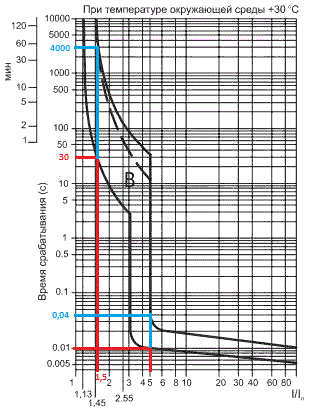
Above, we considered the lower curve, but in the picture there are 3 of them. What is this all for? Let's figure it out. These curves are designed for different states of circuit breakers: "cold" (upper curve) and "hot" (lower curve), and the graph itself is drawn up for an ambient temperature of +30C. The dotted line calculates the shutdown time for an automatic machine with a rating of not more than 32A.
For the cold state of the circuit breaker with characteristic B for the example described above, the delay time for operation will be at a current of 50A - 0.04 sec. and at a current of 15A - 4000 sec. (approximately 67 min.). This is shown in blue in the figure above.
Also note that the machines are in different places- in the apartment, at the entrance, on the street, etc. For example, in winter the temperature at home is +25, at the entrance +16, on the street -25. Accordingly, the temperature of the release elements is different and it needs different time to warm up and make the machine work.
There is also a correction factor here. The lower the ambient temperature, the more current the machine will pass through itself and vice versa. With the same load in hot and cold rooms, the same machine will operate when different meanings current. These fluctuations are not significant and this issue becomes relevant when the circuit breaker is heavily loaded and operates at the limit of its rating. Worth the rise ambient temperature how he can turn off the load. Often this question arises in the summer in hot rooms.
Now I will say a few words about the time-current characteristics of circuit breakers C and D. Their essence lies in the fact that all characteristic graphs are shifted to the right, i.e. thus, the time of their operation increases. An automaton with characteristic C will operate in the event of a short circuit when the current in the network exceeds the rated current of the automaton itself by 5-10 times. An automaton with characteristic D during a short circuit will work when the current in the network exceeds the rated current of the automaton itself by 10-20 times.
From the graphs we get (see below). For automatic machine at 10A of characteristic C, the operation time will already be: at a current of 50A, approximately 0.02 sec. and at a current of 15A approximately 40 sec. This is for the hot state of the machine (red color). For cold state ( Blue colour) we get: at a current of 50A, approximately 27 sec. and at a current of 15A approximately 5000 sec. (83 min.).
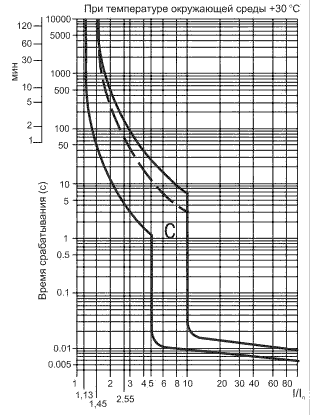
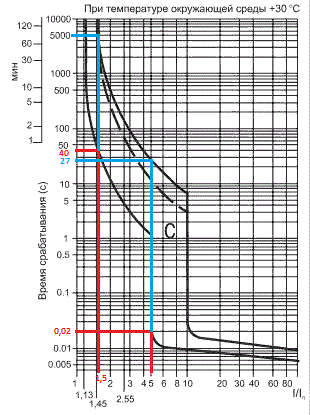
For a 10A automatic machine of characteristic D (see the graphs below), the response time will already be: at a current of 50A, about 1.5 seconds. and at a current of 15A approximately 40 sec. This is for the hot state of the machine (red color). For a cold state (blue color) we get: at a current of 50A, about 30 seconds. and at a current of 15A approximately 6000 sec. (100 min.).
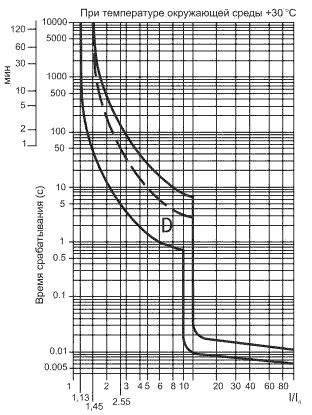
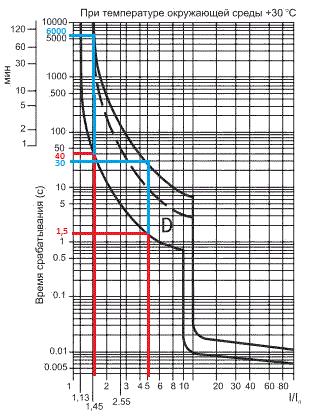
Here you can see the difference in the values of time when the automata are overloaded. This also needs to be known and taken into account when choosing them.
As a rule, automatic switches with characteristic B are used for apartments, and in production - C and D. Although it is very common to find automatic switches with parameter C in floor panels. Automatic switches with parameter B are rarely found on sale.
Also note that each machine can pass through itself a current greater than the rated current by 1.13 times. This can be seen from the graph. You see the value 1.13 on the horizontal axis, and if you draw a conditional line vertically upwards, then it will never cross the time curve. Therefore, the machine at this current will not work. Therefore, choose a cable with a larger cross section, i.e. with a margin. Better be safe.
See for which circuit breakers which corresponds to the non-shutdown current. This is also considered when choosing a circuit breaker at face value and cable.
For example, for a load that consumes a current of 25A, you have chosen a cable with a cross section of 2.5mm2. Then the wife was going to cook dinner, drink tea along the way, defrost meat in the microwave and also brought a hair dryer (which you did not take into account in your calculations) to the kitchen to dry her hair. Thus, instead of 25A, you can get 28A in the network, and the machine will not work here, since it will work at a current of 25A * 1.13 = 28.25A. The table shows that for such a current a wire with a cross section of at least 3 mm2 is already needed. But we have a wire with a cross section of 2.5 mm2 and therefore it will heat up and melt the insulation.
Moreover, take note that many manufacturers are cunning in the production of cables. They make it according to TU ( specifications), at which the cross section of the cable is reduced. I am of the opinion in choosing cable and circuit breakers that it is better to take everything with a reasonable margin than the expected load.
Don't forget to smile:
Why don't I go to work? thought the electrician.
And didn't go...




